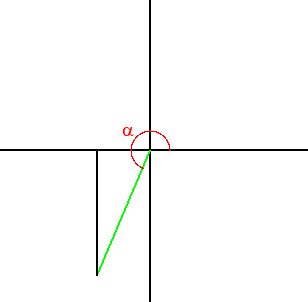Question 625851: If tan α = 12/5, π < α < 3 π/2, and sin β = 2/3, 0< β < π/2, find
A) sin α
B) cos β
C) cos 2 β
D) sin α/2
E) cos (α+ β)
F) sin (α+ β)/2
Answer by Edwin McCravy(20060)   (Show Source): (Show Source):
You can put this solution on YOUR website!
If tan α = 12/5, π < α < 3 π/2, and sin β = 2/3, 0< β < π/2, find
We draw the graphs of the angles,  is in the third
quadrant and is in the third
quadrant and  is in the first: is in the first:
  Next we draw perpendiculars to the x-axis, which creates right
triangles
Next we draw perpendiculars to the x-axis, which creates right
triangles
  Since the tangent is opposite/adjacent or y/x, we take the opposite side of
Since the tangent is opposite/adjacent or y/x, we take the opposite side of
 to be -12 (negative because it goes downward from the x-axis), and
the adjacent to be -5 (negative because it goes left from the origin).
Since the sine is opposite/hypotenuse or y/r, we take the opposite side of to be -12 (negative because it goes downward from the x-axis), and
the adjacent to be -5 (negative because it goes left from the origin).
Since the sine is opposite/hypotenuse or y/r, we take the opposite side of
 to be +2 (positive because it goes upward from the x-axis), and
the hypotenuse r to be 3 (the hypotenuse r is ALWAYS taken positive). to be +2 (positive because it goes upward from the x-axis), and
the hypotenuse r to be 3 (the hypotenuse r is ALWAYS taken positive).
  Next we use the Pythagorean theorem to calculate the hypotenuse r for
Next we use the Pythagorean theorem to calculate the hypotenuse r for  and the adjacent side x for
and the adjacent side x for  .
r² = x² + y² r² = x² + y²
r² = (-5)²+(-12)² 3² = x² + 2²
r² = 25 + 144 9 = x² + 4
r² = 169 5 = x²
r = 13 .
r² = x² + y² r² = x² + y²
r² = (-5)²+(-12)² 3² = x² + 2²
r² = 25 + 144 9 = x² + 4
r² = 169 5 = x²
r = 13  = x = x
  Now we can answer the first two questions by merely looking at the triangles,
and knowing sine = opposite/hypotenuse and cosine = adjacent/hypotenuse,
using x for adjacent, y for opposite and r for hypotenuse:
A) sin α = opp/hyp = y/r = (-12)/13 = -12/13
B) cos β = adj/hyp = x/r =
Now we can answer the first two questions by merely looking at the triangles,
and knowing sine = opposite/hypotenuse and cosine = adjacent/hypotenuse,
using x for adjacent, y for opposite and r for hypotenuse:
A) sin α = opp/hyp = y/r = (-12)/13 = -12/13
B) cos β = adj/hyp = x/r =  /3
To do the others we have to use identities and then we can
substitute as above. I will do C):
C) cos 2β = cos²β-sin²β = ( /3
To do the others we have to use identities and then we can
substitute as above. I will do C):
C) cos 2β = cos²β-sin²β = ( /3)²-(2/3)² = 5/9-4/9=1/9
Now you can do the others by yourself, using the proper identities and
the above graphs:
D) sin α/2
E) cos (α+β)
F) sin (α+β)/2
Edwin /3)²-(2/3)² = 5/9-4/9=1/9
Now you can do the others by yourself, using the proper identities and
the above graphs:
D) sin α/2
E) cos (α+β)
F) sin (α+β)/2
Edwin
|
|
|